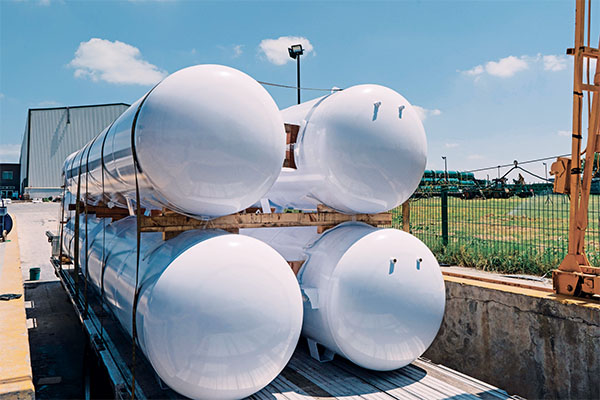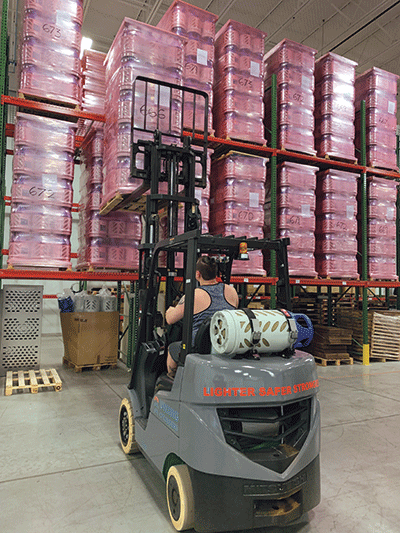Supply, labor challenges shape propane tank production, distribution
Supply chain update
Of the myriad supply disruptions affecting industry since the COVID-19 pandemic began in 2020, propane marketers perhaps have felt steel shortages most acutely.

Rising transportation costs factor into the price of propane tanks. (Photo courtesy of Metsa Tanks Inc.)
The volatility of steel prices over the past several years, caused initially by plant shutdowns during the pandemic and then again by the war in Ukraine, has tested the ability of propane tank manufacturers to predict costs and manage inventory, says Robert Kenney, managing director of Metsa Tanks, located near Monterrey, Mexico.
During the past several months, however, the price of steel has trended downward and stabilized.
“That’s going to start giving us the confidence to start projecting where our costs are going to be in the future,” says Kenney.
Even as steel stabilizes, supply lines for other tank components suffer.
Brass used to manufacture tank valves has become scarce, and the price has shot up in the past two years.
Kenney attributes the brass shortage to the war in Ukraine, where the primary materials used to produce brass have been impacted. Companies that make sub-assemblies are also experiencing the residual effects of the pandemic and, in some cases, have ramped down or shut down production.
In addition, tank manufacturers are weighing higher-than-average transportation costs and supply insecurity – whether by truck, sea cargo or rail. Diesel prices are up for trucks, sea cargo faces higher costs and insecurity, and a strike threatens the security of rail.
Metsa keeps transportation costs down by sourcing steel from nearby plants, explains Kenney.
To ensure a steady supply of tanks for propane marketers, the company also has worked with customers to forecast future needs, increased inventory, brokered contracts with steel mills to ensure a sufficient supply of materials over the long term and diversified supply sources for certain products.
Relying on relationships
Because almost all supply lines that feed into tank production have been affected in some fashion over the past several years, relationships with suppliers and customers are more critical than ever, says D.D. Hardy, director of sales at Quality Steel, based in Cleveland, Mississippi.
He spends time helping propane marketers plan better for the next eight to 10 months to ensure they get the tanks they need.
Also important are relationships with employees. Quality Steel has increased production hours to ensure demand is met and has invested in maintaining a skilled workforce that can meet production goals. Each Quality Steel production facility has dedicated human resources staff, and the company has held more social events to take employees off the line after shifts and build in time for appreciation and enjoyment.
“We’re doing more and more of that at all of our facilities to make sure people understand how important they are from the CEO all the way down to somebody painting a tank,” says Hardy.
Composite cylinders
The forklift and hospitality markets are proving to be that sweet spot for Viking Cylinders’ composite offerings.

Viking Cylinders says it has gained 20 to 30 decent-sized forklift customers over the past couple of years. (Photo by Craig Bruch)
Viking says the ergonomics of its composite cylinders – most notably their lightweight features and translucent cylinder walls – are making a difference with companies emphasizing health, safety and environmental policies and the end-user experience. Employees changing out forklift cylinders or the cylinders fueling patio heaters at resorts and restaurants welcome the easy-handling nature of the product. A full commercial cylinder weighs just over 48 pounds.
“Companies want to keep employees happy right now because they’re so hard to find,” says Sean Ellen, managing director at Viking Cylinders, the North American brand of Hexagon Ragasco.
“If we can get enough new customers to have that experience, it bodes well for us in the future.”
That’s where Viking has directed its focus – introducing its cylinders to the market and converting customers at a time when many companies face challenges related to product costs and lead times.
And in some areas, it’s already working. Ellen says Viking has added 20 to 30 decent-sized forklift customers over the past couple of years.
“The biggest difference from years past is now we have a good book of business, a good customer list and some opportunities that weren’t there previously,” he says. “Just focusing on forklifts has been huge for us.”
While Viking has felt the impact of inflation, Ellen believes the company has kept its prices in check for the most part.
“We’re within 5 percent of where we were last year overall,” he says.
Viking’s business in the U.S. runs out of its 50,000-sq.-ft. final assembly and distribution hub in Heath, Ohio, where employees prepare cylinders arriving from its automated production facility in Norway and ship them to end-use customers.
Ellen says the U.S. facility has allowed Viking to ramp up inventory and quote customers two to three weeks for delivery.
“Having that inventory is a huge advantage,” he says.
Viking remains a niche part of the market, Ellen says, but his hope is that propane industry companies looking to innovate will give composite cylinders a closer look.
“Everyone has a steel cylinder, everyone has an aluminum cylinder, but not everyone has a composite cylinder,” he explains. “This can differentiate your operations.”
Report assesses practices, procedures involving 20-pound cylinders
The National Institute of Standards and Technology (NIST) released its final report, “2022 NCWM-NIST National Survey on 20 lb. LPG (Propane) Cylinders.”
The NIST Office of Weights and Measures (OWM) collaborated with the National Conference on Weights and Measures (NCWM) as well as states and local jurisdictions on the survey.
According to the report, the purpose of the survey was to:
- Determine the accuracy of the stamped tare weight to the actual tare weight by collecting contemporary data;
- Evaluate the methods of sale, fill procedures and price-posting practices used at direct-sale refilling locations; and
- Determine the net weight compliance when performing a cylinder exchange and to determine how much product remains after consumers perform an exchange.
Results are meant to assist stakeholders in establishing improved procedures and oversight of the manufacturing, refilling, reselling and consumer-based transactions for LPG cylinders.
The publication is available at doi.org/10.6028/NIST.SP.2200-01. OWM encourages feedback on the report.
Cylinder gallon sales
The 20-pound cylinder market accounted for 3 percent of total retail propane gallon sales, or 326 million gallons, in 2020, according to a report conducted by Frost & Sullivan on behalf of the Propane Education & Research Council. The sector averaged sales of 1,019 gallons per account. Cylinder market propane sales rose by 5.2 percent in 2020 compared to 2019. The retail propane industry sold 9.44 billion gallons in 2020, the latest year for available sales data.
Relief from natural disasters
“The company has been very responsive to customer needs when there’s been a natural disaster, and quick to respond to help with sending volunteers or if our product is needed, such as recent floods in Kentucky. Also, when hurricane relief is needed. We gear up and we add production, and we provide our products, if needed, to help victims in those circumstances.”
– Jim Alderman, LP Cylinder Service
















